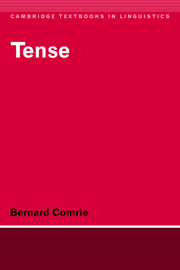6 - Conclusion: Towards a formal theory of tense
Published online by Cambridge University Press: 05 June 2012
Summary
The aim of this chapter is to draw together the major claims set out in chapters 2–5, in particular showing how the generalisations established in those chapters should constrain any formal theory of tense. The aim of this chapter is thus not to build up such a formal theory, but rather to indicate what results of the cross-language study of tense should be taken into account by those who do wish to set up such a formal account. The presentation follows overall the order of presentation of the earlier chapters.
Absolute tense
In order to establish formal representations of absolute tense, it is necessary to specify the present moment, which we shall henceforth abbreviate as S (for moment of speech). In addition, we need to specify a time point or interval which is occupied by the situation to be located in time; we shall refer to this time point or interval as E (for moment of event, though without restricting the use of this abbreviation specifically to events, rather than to situations in general). Notice that E is simply the time at which the situation is located, and is therefore neutral as to whether this is a point or an interval of time longer than a point. Finally, we need to establish some temporal relations that enable us to relate S and E to one another (more accurately, E to S, since we take S as given). The relations in question are before, after, and simul(taneous).
- Type
- Chapter
- Information
- Tense , pp. 122 - 130Publisher: Cambridge University PressPrint publication year: 1985



